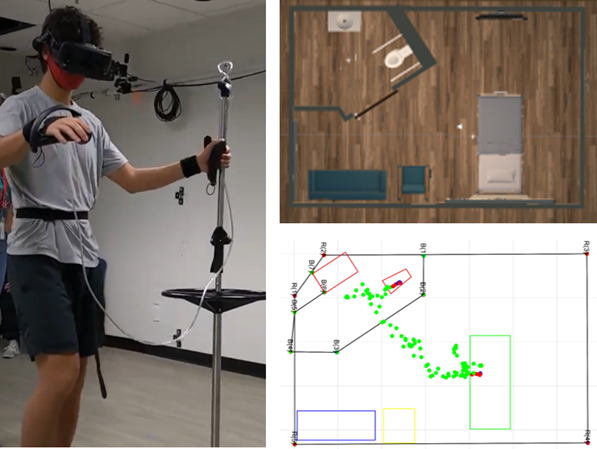Project Background
Despite decades of research into patient falls, falls and related injuries continue to be a serious threat to patient safety. Fall rates continue to be unacceptably high, and even increasing. Research developing fall preventive interventions (such as, the bed alarm and video monitoring) and strategies to protect the patient from injury (such as, hip protectors, compliant flooring) continues, yet the range of preventive and protective interventions is seriously limited.
The investigator's team has been pursuing a new approach where they intend to optimize the layout of the room (e.g., the location of the bed and bathroom, the type of doors used for bathrooms) using a mixed reality approach (virtual reality plus physical reality). A study with healthy young adults has been recently conducted and the research team has been able to identify multiple feasible layouts that could eventually reduce the risk of fall.
The purpose of this project is to translate the previous findings into a physical mock room and evaluate the physical model with frail elderly residents. Physical objects such as doors (e.g., swing, sliding) need to be designed and build, which also needs to be adjustable to different experimental conditions. A study with elderly participants will be conducted. They will be asked to walk between several locations in the room which requires a series of motor tasks (e.g., standing up from the bed, walking to the restroom, opening the door, etc.). Wearable sensors will be placed on the participants to track their movement. Outcome variables such as walking stability will be derived from these user data to draw meaningful conclusions.
Student Role
The undergraduate student is expected to work full-time (40 hours weekly) and will be responsible of three main tasks:
- Design a physical room which needs to be adjustable based on previous findings
- Perform guided experiments with human subjects and collect data,
- Analyze and visualize data.
In the first task, the student will design physical objects in the room based on previous findings from the experiment with the healthy individuals using a mixed reality. The physical objects, such as the door of a mock-up bathroom, need to be adjustable to accommodate different experiment conditions.
In the second task, the student will shadow a graduate student on the human data collection. The student will be responsible of helping the student running the experiment and learning how to use modern sensors to collect human data, such as surface electromyography (EMG) and instrumented insoles for gait. The student will be trained and certified for conducting human research prior to helping the experiments.
In the third task, the student will learn how to process data collected from the human experiments, such as filtering and conditioning. Then, the student will also be responsible to visualize the processed data and compute outcome variables as needed.
Student Learning Outcomes and Benefits
The student will have the opportunity to work in a multidisciplinary laboratory. The PI will provide needed research resources and mentorship throughout the program. A graduate student will be assigned to also mentor the student during his/her stay.
The student is expected to learn skills that are relevant to biomedical research, such as computer-aided design, manufacturing, mechatronics, and testing. Additionally, the student will gain opportunity to work with human experimentation, including movement sensors, data collection and processing, and analysis. This project will help the student learn how to conduct research, how to acquire skills as needed, and how to communicate and collaborate with others in a laboratory setting.
The student may also gain opportunity to present and share his/her results from this novel project through manuscript preparation and conference presentations. The student will be encouraged to complete all programmatic aspects of SPUR, including attending orientation, bi-weekly meetings and weekly URES events, presenting at the Summer Symposium, and publishing an abstract in the University of Utah Undergraduate Research Journal.

Haohan Zhang
The PI will be straightforward with the student and make himself available as much as possible. The PI will clearly describe the research and expectation at the beginning of the program.
The PI will provide the student a desk and a computer for work. The PI will assign a graduate student to closely work with the student. The PI will meet with the student weekly to closely supervise the progress made towards the research goal. Additionally, the student is welcome to schedule other times to meet with the PI to discuss research or other personal needs.
The student is expected to write a short progress report (half-page) weekly to inform the research progress and challenges he/she may be facing. This rapid communication allows the PI to help the student to find solutions or adjust the project appropriately. Additionally, the student is expected to make short presentation bi-weekly during the PI research group meeting. This helps improve the student's communication skills and also provide an opportunity for the entire research to provide critical feedback.
The PI and the graduate student mentor will periodically provide learning tutorials and toy problems to the student as needed. Some examples can be found on PI's website. This will help the student to gain self-learning skills and provide him/her with steppingstones towards solving harder problems.
